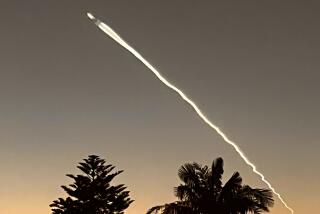Magellan Probe Orbiting Venus : Space: NASA spacecraft hits the brakes and begins circling the hot, cloud-covered planet.
- Share via
Magellan, the first U.S. planetary spacecraft launched since 1978, fired its braking rocket and dropped into orbit around cloud-shrouded Venus today on a mission to find out what turned Earth’s sister planet into a hellish inferno.
“The system worked as planned. A lot of hard work was rewarded,” said George Alexander, chief spokesman for NASA’s Jet Propulsion Laboratory in Pasadena.
“I’m tremendously gratified we were able to do something for NASA and the public that shows this is a capable agency” following troubles with the shuttle fleet and the Hubble Space Telescope, he said. “This breaks the string of bad luck.”
Magellan dived over Venus’ north pole, then ignited the forward-facing rocket at 9:32 a.m., slowing from about 24,600 m.p.h. to roughly 18,500 m.p.h.
That allowed Magellan to be captured by Venus’ gravity and start orbiting the second planet from the sun, said mission commentator Steve Wall.
The rocket ignition happened when the spacecraft was behind Venus, out of radio contact with engineers on Earth. Magellan emerged at 9:53 a.m., but preliminary confirmation that all went well came 13 minutes later because of the time Magellan’s radio signal takes to reach Earth.
“We are now in orbit!” said David Okerson, a Magellan project engineer.
In the Magellan project office, “there was cheering and applause and whistling and hooting” by scientists and engineers, said secretary Sharon Kyle.
Magellan encountered Venus 144 million miles from Earth after circling the sun 1 1/2 times during a roundabout, 948-million-mile journey.
If all goes well, the solar-powered probe will begin firing cloud-piercing radar pulses at Venus around Sept. 1, taking photolike images of the surface that may help determine what caused Venus, so similar to Earth in many ways, to end up the 900-degree inferno it is today, the victim of a runaway “greenhouse effect.”
RENDEZVOUS WITH VENUS The 3.7 ton, unmanned probe entered orbit around Venus today. Some thick clouds perpetually hide the surface of Venus. Magellan’s observations will be done with radar. * Launched: May 4, 1989 from shuttle Atlantis * Primary mission duration: 243 Earth days (begins after 2-3 week testing period in orbit) * Objectives: Map 70-90% of Venus’ surface. Scientists hope Magellan data will help answer questions like: Are Venus’ thousands of volcanoes active? Does Venus have tectonic plates and “continental drift,” like the Earth does? Did Venus once have oceans?






